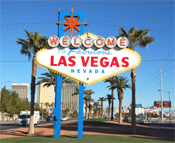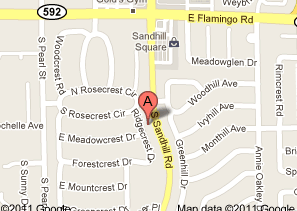The “Welcome To Fabulous Las Vegas” Sign Is Now Listed In The National Register Of Historic Places

 The “Welcome to Fabulous Las Vegas” sign has been listed in the National Register of Historic Places, a significant milestone in the sign’s 50-year history, county and state officials announced today.
The “Welcome to Fabulous Las Vegas” sign has been listed in the National Register of Historic Places, a significant milestone in the sign’s 50-year history, county and state officials announced today.
“We nominated the sign as part of our centennial celebration, believing wholeheartedly in this Las Vegas icon’s historic value,” said County Commission Chairman Rory Reid, whose district includes the sign. “This designation demonstrates that the keepers of the National Register agree. The sign has been not only an important symbol for our community but a magnet for untold thousands who have had their pictures taken in front of it.”
Nevada Historic Preservation Officer Ron James, whose office forwarded the county’s application to the National Park Service for consideration, said the Register is the nation’s official list of cultural resources worthy of recognition and preservation.
“This sign is one of the most recognizable images associated with Nevada and its tourism industry,” said James. “This national honor underscores the historic value of the sign.”
The Welcome sign is located on the median of Las Vegas Boulevard in unincorporated Clark County, just south of the Russell Road exit on Interstate 15. It reads, “Welcome to Fabulous Las Vegas, Nevada” on the front and “Drive Carefully” and “Come Back Soon” on the back.
The sign is owned by Young Electric Sign Company (YESCO) and leased to Clark County. “As owner of the Welcome to Fabulous Las Vegas sign, YESCO is proud to be the stewards of this important cultural resource which has done so much to promote a positive, vibrant image for Las Vegas and Clark County for the past 50 years,” said John Williams, the company’s vice president and general manager.
The sign was designed by Betty Whitehead Willis of Western Neon, at the time one of a few women in the nation working as sign designers. In 1959 a group of Strip hotel owners asked the Clark County Commission to fund the design and construction of a sign to welcome visitors to Las Vegas. The winning bid, from Western Neon, was for $4,000. Later, YESCO bought out Western Neon and became the sign’s owner.
(THERE’S MORE HISTORY about the sign after the jump)
The Welcome sign was placed on the old U.S. Highway 91, which was the main route from Southern California. The closest hotel was the Hacienda, located where Mandalay Bay is now. Clark County Commission meeting minutes in May 1959 note that the sign was to be located just north of the old McCarran airport. It is still at that location, although the main route for travelers is now I-15, and the old McCarran airport is now Signature Executive Terminal.
n the 1990s, another group of hotel owners, thinking the sign had outlived its day, commissioned a study to determine whether a new structure should be built. A public outcry followed and the sign remained. Although YESCO owns the trademark, the image of Welcome sign was never copyrighted, so it has been used freely for commercial and non-commercial purposes over the decades. As a result, it is recognizable internationally and the Welcome sign’s popularity as a tourist destination and photo opportunity continues to grow.
In January, Clark County completed work on a parking lot in the median just south of the sign to enable individuals and groups to safely take pictures of the sign without having to park on the side of the road and run across three lanes of traffic to get there. The new lot also provides access to the sign for the disabled for the first time. Access to the sign had been somewhat limited since its creation in 1959. The new lot features 12 parking spots, including two for the disabled, plus space for two buses.
This year marks the 50th anniversary of the installation of the Welcome sign, which has marked the southern approach to the Strip since 1959.
The county, in its application for placement in the Register, argued that the sign meets National Park Service criteria for being historically significant in these ways:
• “…For its association with the post-World War II entertainment, tourism and advertising industries. The 1950s saw an explosion of casino construction on the Las Vegas Strip, and the 1959 Welcome sign represented the optimism and boosterism of Las Vegas casino owners and civic leaders. The fifties also saw the development of national advertising into a fine art, which made Las Vegas a most desired tourist destination and indeed, a household word across the country and around the world.”
• “Designer Betty Whitehead Willis was a Las Vegas native and daughter of a pioneer southern Nevada family. She attended art school in Los Angeles and had a career as a graphic designer before becoming a sign designer in the early fifties. Willis also designed, among others, the locally treasured Blue Angel Motel sign, and the 1955 Moulin Rouge Hotel and Casino sign.”
• “…As an excellent example of Exaggerated Modern/Googie architecture (1940s-1960s). The sign utilizes a stretched diamond shape with curved sides, set against an angular double column, outlined with light bulbs to accentuate the unusual shape, which are characteristics of Exaggerated Modern/Googie. The sign has become a cultural icon, known and loved around the world, not just because of its historical value and association with Las Vegas, but also because it is one of the dwindling examples of Exaggerated Modern in the southwest and especially in Las Vegas.”
The National Register provides recognition for properties regarded as historically or architecturally significant. For a current list of properties in the National Register of Historic Places and Nevada State Register of Historic Places, visit the State Historic Preservation Office’s Web site at www.NevadaCulture.org (click on SHPO). For more information, call Ron James at (775) 684-3440.
Clark County is marking its 100th birthday in 2009 with a year-long series of events, exhibits, programs and publications. The centennial features a year-long exhibit at the Clark County Museum in Henderson, the opening of a historic wedding chapel and a 1910 railroad cottage, the opening of an Old Spanish Trail Park, monthly history panel discussions being aired live and on tape on Clark County Television (CCTV) Channel 4, dedications of historic markers, burial of a time capsule in December, a history-themed “geocaching” project and more. Smaller events throughout urban and rural Clark County will showcase the county’s mining, ranching, farming, military and tourism heritage.
Additional information about the centennial is available at www.AccessClarkCounty.com/100. There, one can find information, resources, historic trivia contests and a place to submit your historical thoughts and experiences. Residents also may add themselves to an electronic mailing list to stay abreast of centennial updates. Clark County was formed on July 1, 1909, out of what had been Lincoln County. The city of Las Vegas, which includes downtown and the area north of the Las Vegas Strip, would be formed two years later in 1911.
###
Clark County is a dynamic and innovative organization dedicated to providing top-quality service with integrity, respect and accountability. With jurisdiction over the world-famous Las Vegas Strip and covering an area the size of New Jersey, Clark is the nation’s 15th-largest county and provides extensive regional services to more than 2 million citizens and 44 million visitors a year. Included are the nation’s 7th-busiest airport, air quality compliance, social services and the state’s largest public hospital, University Medical Center. The county also provides municipal services that are traditionally provided by cities to almost 900,000 residents in the unincorporated area. Those include fire protection, roads and other public works, parks and recreation, and planning and development. In 2009, Clark County celebrates a “century of service.”
The State Historic Preservation Office is an agency of the Nevada Department of Cultural Affairs. The Department serves Nevada’s citizens and visitors through cultural and information management, presentation and promotion of cultural resources, and education. The Department also includes the Division of Museums and History, Nevada State Library and Archives, Nevada Arts Council, and Commission for Cultural Affairs. For more information on the Department of Cultural Affairs, please call Ron James or Teresa Moiola at (775) 687-8323, or visit the department’s website at www.NevadaCulture.org.


